
History of Army ROTC at Loyola
The Reserve Officers' Training Corps- or ROTC- was established with the National Defense Authorization Act of 1916, not long before the U.S. involvement in the First World War. While officer training programs at civilian colleges have been around since the early 19th century in the United States, the 1916 act created the federally-controlled organization that exists today.
The importance of military training was realized by the President and the Board of Regents of Loyola University Chicago during World War II. The appalling fact was that few graduates of Loyola rose to be officers. Although well educated, these graduates had had no training in military skills and consequently were unable to compete with other draftees who had some military training. Therefore, nearly all Loyola University Chicago students and graduates who were drafted or volunteered during the war completed military service as enlisted soldiers, rather than commissioned officers.
Accordingly, Loyola University Chicago President Rev. James T. Hussey, S.J., decided to submit an application for an Army Reserve Officers Training Unit in 1946. The War Department approved the request, and an ROTC unit was established on July 1, 1947, to produce Infantry and Medical officers. The first cadets of Loyola University Chicago's "Rambler" Battalion enrolled in September 1948, forming a cadet corps of one hundred in strength. The Loyola University Drill Team was later established in 1949, and in 1950 Loyola's ROTC program commissioned its very first group of officers.
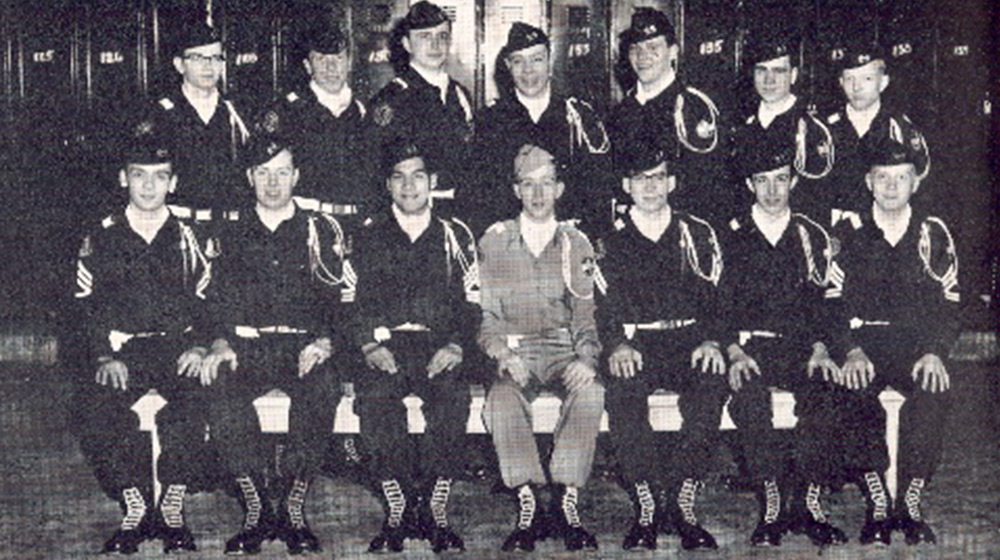
Photo courtesy Loyola Web Archives
Click here to see the original War Department Order from 1947 establishing Army ROTC at Loyola.
Click here to read a 1971 Article on Army ROTC at Loyola by GEN (then MAJ) George Joulwan.
Click here to see Official US Army Institute of Heraldry information on Loyola Army ROTC's original insignia.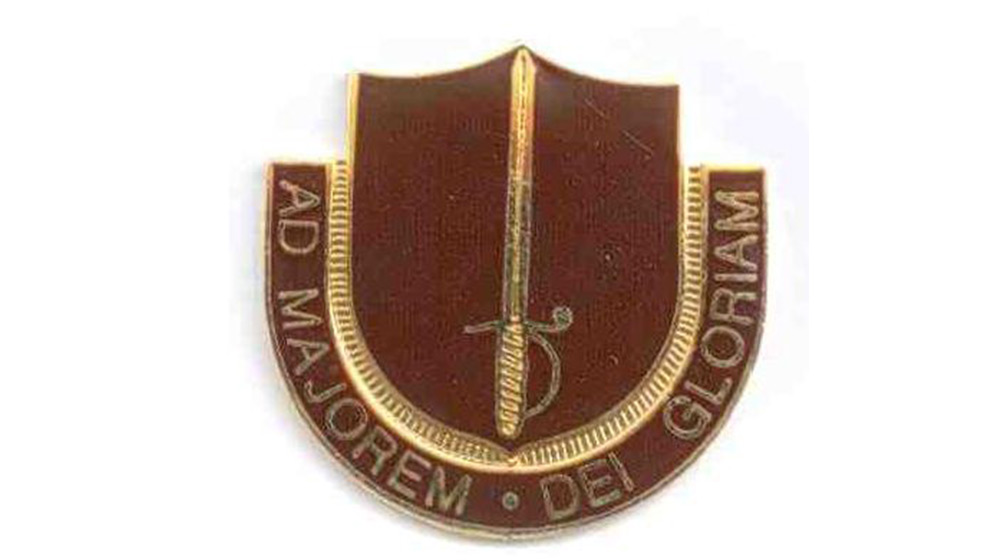
After considerable study and correspondence with the Department of the Army, a general Military Science unit, which allowed cadets to be commissioned in all branches of the Army, superseded the original Infantry and Medical unit curriculum in September 1953. Instruction in all branches was phased in and officially began in September 1954.
From 1953 until September 1959 the ROTC course of instruction spilt into two phases—the basic course and the advanced course. Each phase lasted two years. In the basic course (freshman and sophomore years) all study was an “on campus” nature and involved three hours of work per week or a total of 180 hours for two years. The Advanced Course (junior and senior years) consisted of five hours per week or a total of 300 hours plus a summer camp training session of six weeks, normally held following the junior year.
The curriculum was further revised in September 1959 when the advanced course's classroom hours were reduced from five to three hours a week. The reduction allowed cadets to take an academic subject with another department of the university which would be applied for credit in the military science program. In 1961, a reduction of one hour was made in the basic course of instruction. As with the advanced course, this reduction of credit hours allowed the student to take another academic subject for institutional credit.
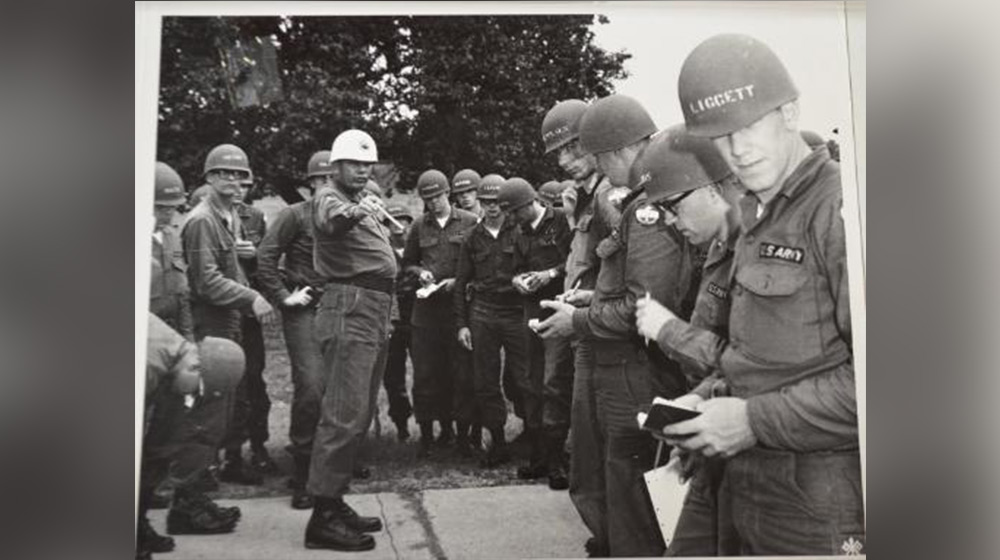 In April 1961, an Advisory Panel on ROTC Affairs, first formed in 1952 and comprised of outstanding educators and top-level military representative, recommended far-reaching changes in the ROTC program which had profound effects on Loyola ROTC. The 1964 ROTC Vitalization Act based on these recommendations, resulted in several changes.
In April 1961, an Advisory Panel on ROTC Affairs, first formed in 1952 and comprised of outstanding educators and top-level military representative, recommended far-reaching changes in the ROTC program which had profound effects on Loyola ROTC. The 1964 ROTC Vitalization Act based on these recommendations, resulted in several changes.
A two year program was created, as were two and four year scholarships. Enrollment began to grow dramatically.
A new contract was signed between Loyola and the Army in 1965, reestablishing the program as a four year course of military instruction.
The year 1968 was a tumultuous time for Loyola and the world. Military Science petitioned and received an upgrade from program status to recognition as a full-fledged department of the University.
In September 1968, a revolutionary curriculum change, called Option C, was instituted at the Loyola Military Science Department. The new curriculum was developed at only 11 of 280 universities which offered college-level Army ROTC programs. The major change under Option C occurred in the basic course, where history and political science courses were taught jointly by civilian and military faculty and substituted for military subjects.
Loyola’s selection to participate in the program change was considered indicative of the quality and stability of the Military Science Department, and the cooperative spirit of the University administrators, faculty and students.
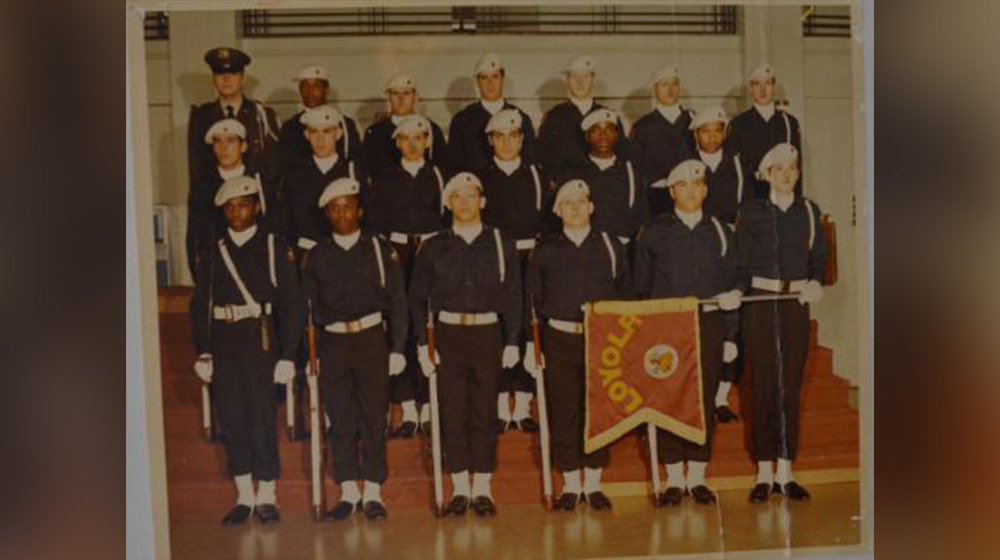
Enrollment declined through the mid-1970s as a result of the Vietnam conflict. In school year 1974-1975, the entire Battalion totaled 84 cadets. Due to declining enrollments at all college ROTC programs in the area and the proximity of other ROTC detachments in Chicago, much discussion was given to consolidation of the city’s detachments. In 1973, consideration was given to consolidation of detachments and centralizing ROTC programs off-campus to a location such as an armory.
DePaul University’s ROTC program was suffering from an even more severe drop in enrollment. The Department of the Army (DA) initiated an intensified management plan which ultimately resulted in the deactivation of DePaul as an ROTC detachment. On October 22nd, 1976, the programs combined to officially create Loyola-DePaul Senior ROTC Instructor Group. Beyond the administrative manpower cost savings, it proved to be a successful example of the DA's consolidation theory. The universities continued to be staunch supporters of their Military Science Departments, and every effort was made to retain their status as distinct and separate units, whenever possible.
Pursuant to DA guidance, women were offered entry into the basic program in 1973. Eleven women took the challenge during that year. The first female officer was commissioned in 1977. Approximately fifty women received their commissions through the Loyola-DePaul ROTC program from 1977 to 1991.
A staff-study, nicknamed the “Subway Study” was conducted by the Loyola Instructor Group in 1978, at the behest of the ROTC's Second Region Commander to study the feasibility of tying the Chicago programs together via the subway-rapid transit system. The idea was abandoned due to extensive travel time considerations for students and instructors.

Enrollment again expanded through the early 1980s. Northwestern University in Evanston, Illinois, and Northeastern Illinois Sates University entered into cross-enrollment agreements and contributed to the increase. Enrollments steadily declined, despite these additional institutional partnerships, in the late 1980s. The primary reason for this decline was due to socio-economic changes among the student population in and around the city of Chicago.
On May 17th, 1991, the Loyola-DePaul Senior Army ROTC Battalion commissioned its last seven officers and cased its colors in deactivation. A new era began as the Loyola-DePaul program consolidated under the University of Illinois-Chicago's “Fire” Battalion.
In 2011, U.S. Army Cadet Command began the process of creating the Rambler Battalion once again, and in 2013, after twenty-two years of consolidation under the University of Illinois-Chicago, Loyola University Chicago reactivated as a provisional battalion. The Rambler Battalion's original 1947 colors were delivered to the program and officially uncased in 2016, beginning a new era for the program and the university. In the years following the separation of the Rambler Battalion from the Fire Battalion, the program has experienced tremendous growth and development, in no small part due to the quality of its cadets and the cadre who call the Rambler Battalion "home".
Loyola provides its graduates with the education necessary for them to take their place as leaders in their community and in service as a "person for others". The Reserve Officers’ Training Corps provides the training, experience, and skills which enable Loyola’s graduates to take their rightful place as leaders of soldiers and in service of their country.
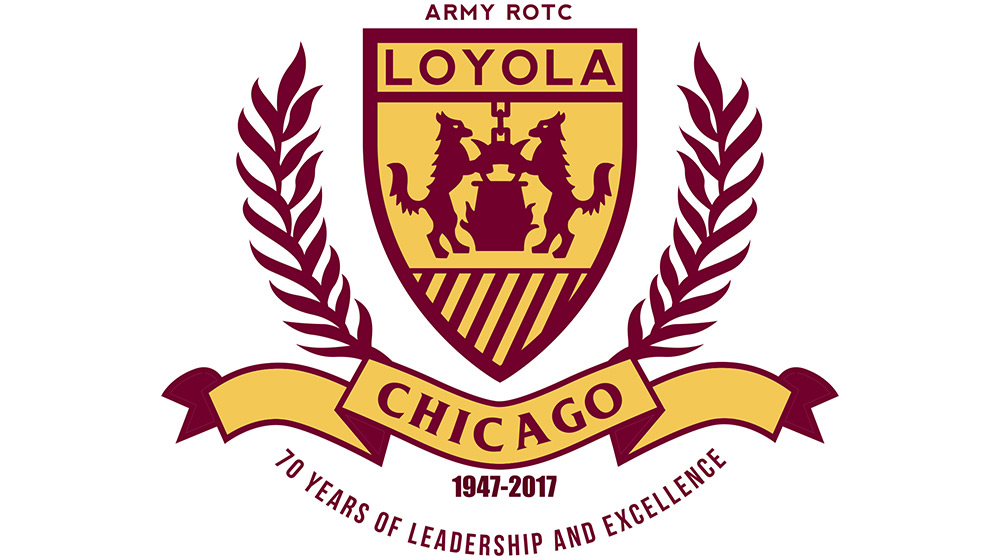
The Reserve Officers' Training Corps- or ROTC- was established with the National Defense Authorization Act of 1916, not long before the U.S. involvement in the First World War. While officer training programs at civilian colleges have been around since the early 19th century in the United States, the 1916 act created the federally-controlled organization that exists today.
The importance of military training was realized by the President and the Board of Regents of Loyola University Chicago during World War II. The appalling fact was that few graduates of Loyola rose to be officers. Although well educated, these graduates had had no training in military skills and consequently were unable to compete with other draftees who had some military training. Therefore, nearly all Loyola University Chicago students and graduates who were drafted or volunteered during the war completed military service as enlisted soldiers, rather than commissioned officers.
Accordingly, Loyola University Chicago President Rev. James T. Hussey, S.J., decided to submit an application for an Army Reserve Officers Training Unit in 1946. The War Department approved the request, and an ROTC unit was established on July 1, 1947, to produce Infantry and Medical officers. The first cadets of Loyola University Chicago's "Rambler" Battalion enrolled in September 1948, forming a cadet corps of one hundred in strength. The Loyola University Drill Team was later established in 1949, and in 1950 Loyola's ROTC program commissioned its very first group of officers.

Photo courtesy Loyola Web Archives
Click here to see the original War Department Order from 1947 establishing Army ROTC at Loyola.
Click here to read a 1971 Article on Army ROTC at Loyola by GEN (then MAJ) George Joulwan.
Click here to see Official US Army Institute of Heraldry information on Loyola Army ROTC's original insignia.
After considerable study and correspondence with the Department of the Army, a general Military Science unit, which allowed cadets to be commissioned in all branches of the Army, superseded the original Infantry and Medical unit curriculum in September 1953. Instruction in all branches was phased in and officially began in September 1954.
From 1953 until September 1959 the ROTC course of instruction spilt into two phases—the basic course and the advanced course. Each phase lasted two years. In the basic course (freshman and sophomore years) all study was an “on campus” nature and involved three hours of work per week or a total of 180 hours for two years. The Advanced Course (junior and senior years) consisted of five hours per week or a total of 300 hours plus a summer camp training session of six weeks, normally held following the junior year.
The curriculum was further revised in September 1959 when the advanced course's classroom hours were reduced from five to three hours a week. The reduction allowed cadets to take an academic subject with another department of the university which would be applied for credit in the military science program. In 1961, a reduction of one hour was made in the basic course of instruction. As with the advanced course, this reduction of credit hours allowed the student to take another academic subject for institutional credit.
 In April 1961, an Advisory Panel on ROTC Affairs, first formed in 1952 and comprised of outstanding educators and top-level military representative, recommended far-reaching changes in the ROTC program which had profound effects on Loyola ROTC. The 1964 ROTC Vitalization Act based on these recommendations, resulted in several changes.
In April 1961, an Advisory Panel on ROTC Affairs, first formed in 1952 and comprised of outstanding educators and top-level military representative, recommended far-reaching changes in the ROTC program which had profound effects on Loyola ROTC. The 1964 ROTC Vitalization Act based on these recommendations, resulted in several changes.
A two year program was created, as were two and four year scholarships. Enrollment began to grow dramatically.
A new contract was signed between Loyola and the Army in 1965, reestablishing the program as a four year course of military instruction.
The year 1968 was a tumultuous time for Loyola and the world. Military Science petitioned and received an upgrade from program status to recognition as a full-fledged department of the University.
In September 1968, a revolutionary curriculum change, called Option C, was instituted at the Loyola Military Science Department. The new curriculum was developed at only 11 of 280 universities which offered college-level Army ROTC programs. The major change under Option C occurred in the basic course, where history and political science courses were taught jointly by civilian and military faculty and substituted for military subjects.
Loyola’s selection to participate in the program change was considered indicative of the quality and stability of the Military Science Department, and the cooperative spirit of the University administrators, faculty and students.

Enrollment declined through the mid-1970s as a result of the Vietnam conflict. In school year 1974-1975, the entire Battalion totaled 84 cadets. Due to declining enrollments at all college ROTC programs in the area and the proximity of other ROTC detachments in Chicago, much discussion was given to consolidation of the city’s detachments. In 1973, consideration was given to consolidation of detachments and centralizing ROTC programs off-campus to a location such as an armory.
DePaul University’s ROTC program was suffering from an even more severe drop in enrollment. The Department of the Army (DA) initiated an intensified management plan which ultimately resulted in the deactivation of DePaul as an ROTC detachment. On October 22nd, 1976, the programs combined to officially create Loyola-DePaul Senior ROTC Instructor Group. Beyond the administrative manpower cost savings, it proved to be a successful example of the DA's consolidation theory. The universities continued to be staunch supporters of their Military Science Departments, and every effort was made to retain their status as distinct and separate units, whenever possible.
Pursuant to DA guidance, women were offered entry into the basic program in 1973. Eleven women took the challenge during that year. The first female officer was commissioned in 1977. Approximately fifty women received their commissions through the Loyola-DePaul ROTC program from 1977 to 1991.
A staff-study, nicknamed the “Subway Study” was conducted by the Loyola Instructor Group in 1978, at the behest of the ROTC's Second Region Commander to study the feasibility of tying the Chicago programs together via the subway-rapid transit system. The idea was abandoned due to extensive travel time considerations for students and instructors.

Enrollment again expanded through the early 1980s. Northwestern University in Evanston, Illinois, and Northeastern Illinois Sates University entered into cross-enrollment agreements and contributed to the increase. Enrollments steadily declined, despite these additional institutional partnerships, in the late 1980s. The primary reason for this decline was due to socio-economic changes among the student population in and around the city of Chicago.
On May 17th, 1991, the Loyola-DePaul Senior Army ROTC Battalion commissioned its last seven officers and cased its colors in deactivation. A new era began as the Loyola-DePaul program consolidated under the University of Illinois-Chicago's “Fire” Battalion.
In 2011, U.S. Army Cadet Command began the process of creating the Rambler Battalion once again, and in 2013, after twenty-two years of consolidation under the University of Illinois-Chicago, Loyola University Chicago reactivated as a provisional battalion. The Rambler Battalion's original 1947 colors were delivered to the program and officially uncased in 2016, beginning a new era for the program and the university. In the years following the separation of the Rambler Battalion from the Fire Battalion, the program has experienced tremendous growth and development, in no small part due to the quality of its cadets and the cadre who call the Rambler Battalion "home".
Loyola provides its graduates with the education necessary for them to take their place as leaders in their community and in service as a "person for others". The Reserve Officers’ Training Corps provides the training, experience, and skills which enable Loyola’s graduates to take their rightful place as leaders of soldiers and in service of their country.

